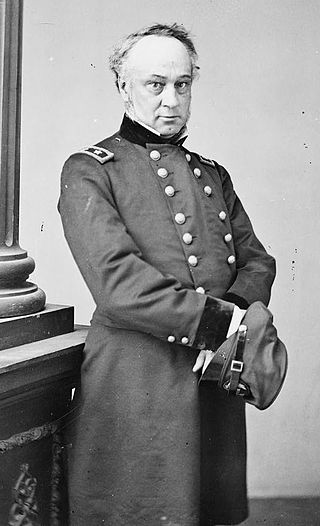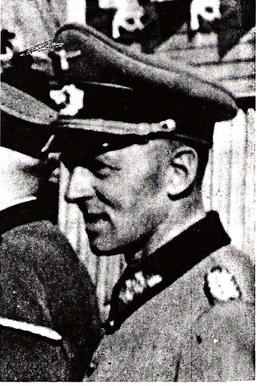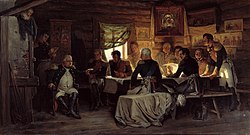
The Battle of Gettysburg was a three-day battle in the American Civil War fought between Union and Confederate forces between July 1 and July 3, 1863, in and around Gettysburg, Pennsylvania. The battle, which was won by the Union, was the Civil War's turning point, ending the Confederacy's aspirations to establish an independent nation, and the war's bloodiest battle, claiming some 50,000 combined casualties.

Robert Edward Lee was a Confederate general during the American Civil War, toward the end of which he was appointed the overall commander of the Confederate States Army. He led the Army of Northern Virginia—the Confederacy's most powerful army—from 1862 until its surrender in 1865, earning a reputation as a skilled tactician.

The Battle of Chancellorsville, April 30 – May 6, 1863, was a major battle of the American Civil War (1861–1865), and the principal engagement of the Chancellorsville campaign.

The Battle of Fredericksburg was fought December 11–15, 1862, in and around Fredericksburg, Virginia, in the Eastern Theater of the American Civil War. The combat, between the Union Army of the Potomac commanded by Maj. Gen. Ambrose Burnside and the Confederate Army of Northern Virginia under Gen. Robert E. Lee, included futile frontal attacks by the Union army on December 13 against entrenched Confederate defenders along the Sunken Wall on the heights behind the city. It is remembered as one of the most one-sided battles of the war, with Union casualties more than twice as heavy as those suffered by the Confederates. A visitor to the battlefield described the battle as a "butchery" to U.S. President Abraham Lincoln.

The Battle of the Wilderness was fought on May 5–7, 1864, during the American Civil War. It was the first battle of Lieutenant General Ulysses S. Grant's 1864 Virginia Overland Campaign against General Robert E. Lee and the Confederate Army of Northern Virginia. The fighting occurred in a wooded area near Locust Grove, Virginia, about 20 miles (32 km) west of Fredericksburg. Both armies suffered heavy casualties, nearly 29,000 in total, a harbinger of a war of attrition by Grant against Lee's army and, eventually, the Confederate capital, Richmond, Virginia. The battle was tactically inconclusive, as Grant disengaged and continued his offensive.

George Gordon Meade was a United States Army Major General who commanded the Army of the Potomac during the American Civil War from 1863 to 1865. He fought in many of the key battles of the Eastern theater and defeated the Confederate Army of Northern Virginia led by General Robert E. Lee at the Battle of Gettysburg.

Joseph Hooker was an American Civil War general for the Union, chiefly remembered for his decisive defeat by Confederate General Robert E. Lee at the Battle of Chancellorsville in 1863.

A commander in chief or supreme commander is the person who exercises supreme command and control over an armed force or a military branch. As a technical term, it refers to military competencies that reside in a country's executive leadership, a head of state, head of government, or other designated government official.

Henry Wager Halleck was a senior United States Army officer, scholar, and lawyer. A noted expert in military studies, he was known by a nickname that became derogatory: "Old Brains". He was an important participant in the admission of California as a state and became a successful lawyer and land developer. Halleck served as the General-in-Chief of the Armies of the United States from 1862 to 1864, and then became Chief of Staff for the remainder of the war when Ulysses S. Grant was appointed to that position.

Henry Warner Slocum Sr., was a Union general during the American Civil War and later served in the United States House of Representatives from New York. During the war, he was one of the youngest major generals in the Army and fought numerous major battles in the Eastern Theater and in Georgia and the Carolinas. While commanding a regiment, a brigade, a division, and a corps in the Army of the Potomac, he saw action at First Bull Run, the Peninsula Campaign, Harpers Ferry, South Mountain, Antietam, and Chancellorsville.

The Killer Angels is a 1974 historical novel by Michael Shaara that was awarded the Pulitzer Prize for Fiction in 1975. The book depicts the three days of the Battle of Gettysburg during the American Civil War, and the days leading up to it: June 29, 1863, as the troops of both the Union and the Confederacy move into battle around the town of Gettysburg, Pennsylvania, and July 1, July 2, and July 3, when the battle was fought. The story is character-driven and told from the perspective of various historical figures from both the Confederacy and the Union. A film adaptation of the novel, titled Gettysburg, was released in 1993.

Gouverneur Kemble Warren was an American civil engineer and United States Army general during the American Civil War. He is best remembered for arranging the last-minute defense of Little Round Top during the Battle of Gettysburg and is often referred to as the "Hero of Little Round Top". His subsequent service as a corps commander and his remaining military career were ruined during the Battle of Five Forks, when he was relieved of command of the V Corps by Philip Sheridan, who claimed that Warren had moved too slowly. A post-war court of inquiry found that Sheridan's relief of Warren was unjustified.

A military staff or general staff is a group of officers, enlisted and civilian staff who serve the commander of a division or other large military unit in their command and control role through planning, analysis, and information gathering, as well as by relaying, coordinating, and supervising the execution of their plans and orders, especially in case of multiple simultaneous and rapidly changing complex operations. They are organised into functional groups such as administration, logistics, operations, intelligence, training, etc. They provide multi-directional flow of information between a commanding officer, subordinate military units and other stakeholders. A centralised general staff results in tighter top-down control but requires larger staff at headquarters (HQ) and reduces accuracy of orientation of field operations, whereas a decentralised general staff results in enhanced situational focus, personal initiative, speed of localised action, OODA loop, and improved accuracy of orientation.

Alfred Pleasonton was a United States Army officer and major general of volunteers in the Union cavalry during the American Civil War. He commanded the Cavalry Corps of the Army of the Potomac during the Gettysburg campaign, including the largest predominantly cavalry battle of the war, Brandy Station. In 1864, he was transferred to the Trans-Mississippi theater, where he defeated Confederate General Sterling Price in two key battles, including the Battle of Mine Creek, the second largest cavalry battle of the war, effectively ending the war in Missouri. He was the son of Stephen Pleasonton and younger brother of Augustus Pleasonton.
Mission-type tactics is a method of command and delegation where the military commander gives subordinate leaders a clearly-defined objective, high-level details such as a timeframe, and the forces needed to accomplish that objective. The subordinate leaders are given the planning initiative and freedom of execution: they decide on the methods to achieve the objective independently. This allows a high degree of flexibility at the operational and tactical levels of command, which allows for faster decision-making on the ground and frees the higher leadership from managing the tactical details to concentrate on the strategic picture. This may be contrasted with "Befehlstaktik" or command-type tactics.

During the second day of the Battle of Gettysburg Confederate Gen. Robert E. Lee attempted to capitalize on his first day's accomplishments. His Army of Northern Virginia launched multiple attacks on the flanks of the Union Army of the Potomac, commanded by Maj. Gen. George G. Meade. The assaults were unsuccessful, and resulted in heavy casualties for both sides.

In the practice of international law, Command Responsibility is the legal doctrine of hierarchical accountability for war crimes, whereby a commanding officer (military) and a superior officer (civil) is legally responsible for the war crimes and the crimes against humanity committed by his subordinates; thus, a commanding officer always is accountable for the acts of commission and the acts of omission of his soldiers.

The term staff ride describes three different types of military exercises and examinations, usually conducted on a particular future battlefield and/or area of operation for the purpose of preliminary reconnaissance, terrain study and tactical preparation. As the Classic Staff Ride, the Leavenworth Staff Ride and the Decision-Forcing Staff Ride have been subjected to modern military scholarly work, the idea and practice of battlefield examination and exploitation has been documented throughout history. As early as 500 years BC, the Chinese general Sun Tzu emphasized the rigorous study of the terrain. Notable military commanders, such as Hannibal, Napoleon or Frederick the Great have regularly studied the terrain and exploited to its full advantage.

The Confederate Army of Northern Virginia began its Retreat from Gettysburg on July 4, 1863. Following General Robert E. Lee's failure to defeat the Union Army at the Battle of Gettysburg, he ordered a retreat through Maryland and over the Potomac River to relative safety in Virginia. The Union Army of the Potomac, commanded by Maj. Gen. George G. Meade, was unable to maneuver quickly enough to launch a significant attack on the Confederates, who crossed the river on the night of July 13 into South Mountain through Cashtown in a wagon train that extended for 15–20 miles, enduring harsh weather, treacherous roads, and enemy cavalry raids. The bulk of Lee's infantry departed through Fairfield and through the Monterey Pass toward Hagerstown, Maryland. Reaching the Potomac, they found that rising waters and destroyed pontoon bridges prevented their immediate crossing. Erecting substantial defensive works, they awaited the arrival of the Union army, which had been pursuing over longer roads more to the south of Lee's route. Before Meade could perform adequate reconnaissance and attack the Confederate fortifications, Lee's army escaped across fords and a hastily rebuilt bridge.

Arthur Schmidt was an officer in the German military from 1914 to 1943. He attained the rank of Generalleutnant during World War II, and is best known for his role as the Sixth Army's chief of staff in the Battle of Stalingrad in 1942–43, during the final stages of which he became its de facto commander, playing a large role in executing Hitler's order that it stand firm despite being encircled by the Red Army. He was a prisoner of war in the Soviet Union for twelve years, and was released following West German chancellor Konrad Adenauer's visit to Moscow in 1955.




















